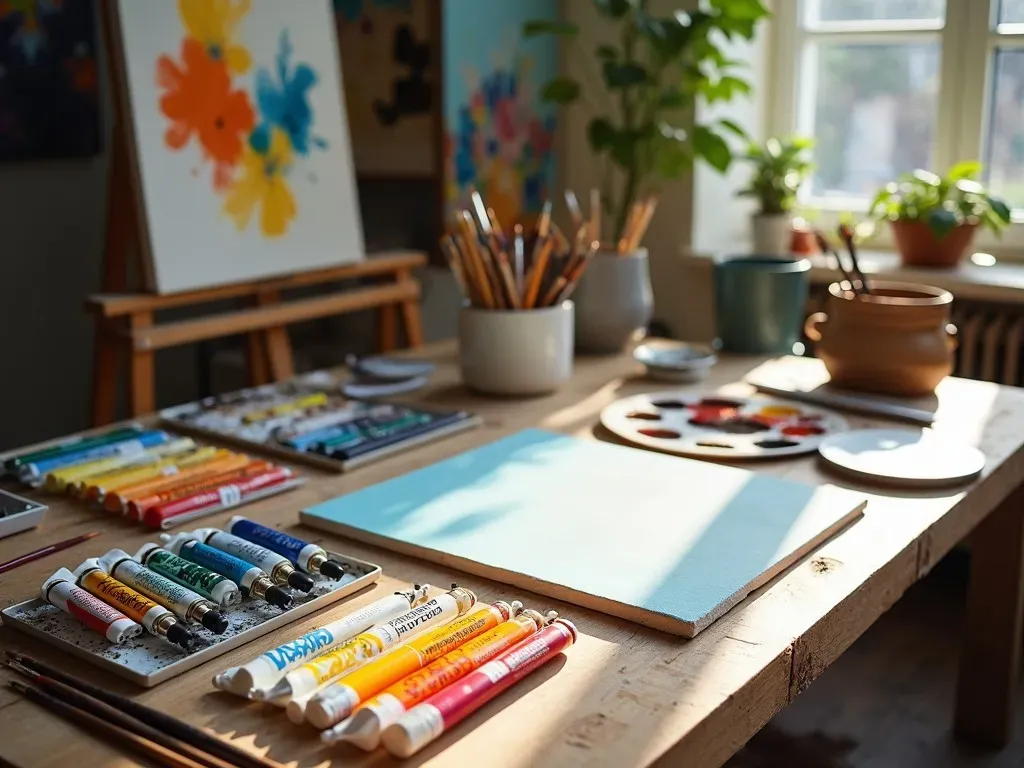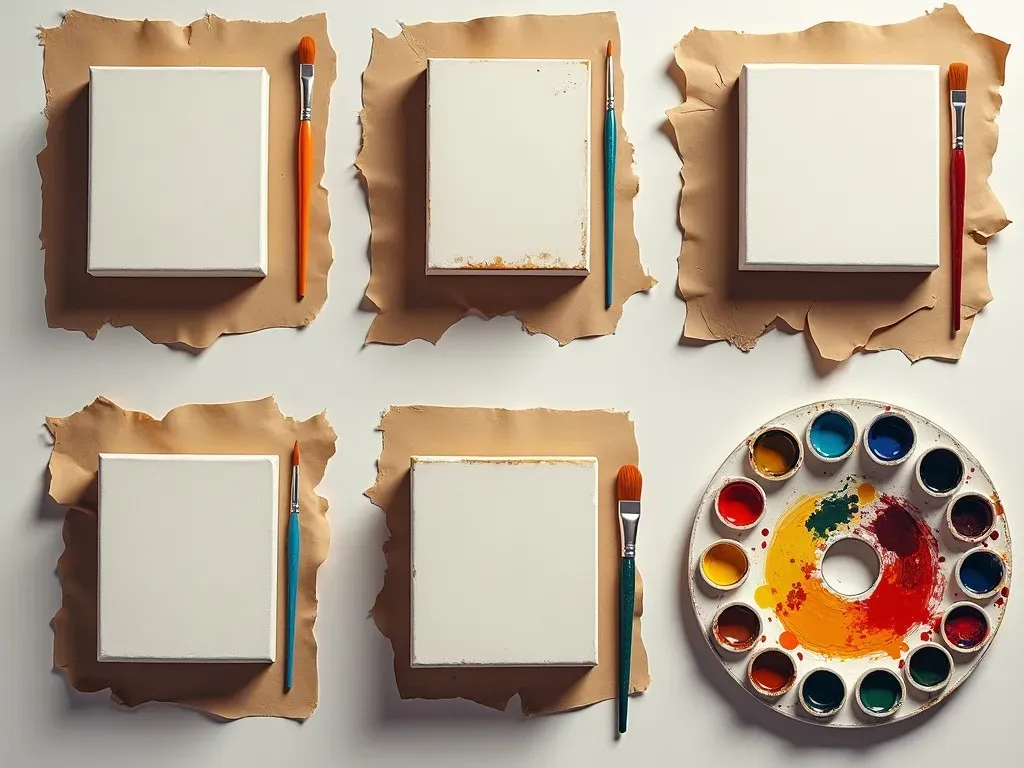Oil painting Supplies are essential tools that every artist, from beginners to seasoned professionals, needs to bring their artistic visions to life. A comprehensive understanding of these materials is key to being successful in the world of oil painting. With the right oil painting supplies, anyone can embark on an artistic journey filled with color, creativity, and self-expression.
The Essential Oil Painting Supplies List
-
Oil Paints
- Student-grade vs. professional-grade
- Color palette basics
- Common brands: Winsor & Newton, Gamblin, and Grumbacher
-
Brushes
- Types (Filbert, Round, Flat, etc.)
- Materials (Synthetic vs. Natural)
- Recommended sizes for different Techniques
-
Palettes
- Types (Wood, Glass, Disposable)
- Importance of color mixing
- Tips for maintaining your palette
-
Canvases and Surfaces
- Pre-stretched vs. canvas boards
- Linen vs. cotton
- Choosing the right texture
-
Solvents and Mediums
- Thinners (like turpentine or odorless mineral spirits)
- Mediums (Linseed oil, Liquin)
- Importance of ventilation when using solvents
-
Easels
- Different types (Tabletop, Studio, Field)
- Importance of stability and height adjustability
-
Other Accessories
- Palette knives for mixing and scraping
- Rags and paper towels for cleaning
- Varnishes for finished artworks
Breakdown of Oil Painting Supplies
| Item | Description | Price Range |
|---|---|---|
| Oil Paints | Tubes of varying colors | $5 – $100 |
| Brushes | Various sizes and shapes | $5 – $50 |
| Palettes | Mixing surfaces | $3 – $30 |
| Canvases | Pre-stretched and boards | $10 – $200 |
| Solvents/Mediums | Thinners and additives | $5 – $35 |
| Easels | Supports for canvases | $20 – $200 |
| Accessories | Tools like knives and cleaning | $5 – $50 |

What Do You Need for Oil Painting?
Starting oil painting could feel overwhelming at times, especially with numerous supplies available. However, a basic set of items is all you need to get started. For beginners, a starter kit may be the best way to go. The following is a short checklist of beginner oil painting supplies that you should consider:
- A basic oil painting starter kit with paints, brushes, and a palette
- A few pre-stretched canvases or a canvas pad
- A medium and a solvent
- High-quality brushes in multiple shapes and sizes
- An adjustable easel and mixing tools like palette knives
- Clean rags for wiping brushes and hands
Beginner Oil Painting Supplies: Essential Considerations
When selecting oil painting supplies, consider quality over quantity. Here are tips to help you make informed choices:
-
Invest in Quality Paints: While it’s tempting to buy the cheapest paint, high-quality oil paints yield better colors and longevity.
-
Get a Variety of Brushes: A range of brush shapes will offer versatility for different techniques.
-
Keep Your Workspace Organized: An orderly area simplifies the painting process and enhances creativity.
-
Practice Color Mixing: Understanding how to mix colors will expand your creative possibilities significantly.
Common Questions About Oil Painting Supplies
What are the basic supplies needed for oil painting?
Basic supplies include oil paints, brushes (various shapes and sizes), a palette for mixing colors, canvases or canvas boards, a medium (like linseed oil), a solvent, and an easel.
Can I use acrylic brushes for oil painting?
While acrylic brushes can technically be used for oil painting, it’s recommended to use brushes designed for oil paints, as they are sturdier and have the right bristle type and texture.
How do I maintain my oil painting supplies?
To maintain brushes, clean them thoroughly with soap and water right after use. Store your paints in a cool, dry place, and regularly check and clean your palette.
Where can I buy oil painting supplies?
Many art supply stores, both online and in-person, offer a wide range of oil painting supplies. Some popular options include Dick Blick and Amazon.
Popular Oil Painting Supplies Brands
| Brand | Specialization |
|---|---|
| Winsor & Newton | Professional artist oil paints |
| Gamblin | High-quality oil mediums and paints |
| Grumbacher | Reliable for beginners and professionals |
| Holbein | Vibrant colors and unique color sets |
| Sennelier | Classic French oil paints |
Tips to Enhance Your Oil Painting Experience
-
Create a Color Mixing Guide: As you start to mix colors, keep track by creating a color mixing guide that records what combinations yield specific shades.
-
Experiment with Mediums: Different mediums can alter the consistency and drying time of your paint. Experimentation can lead to unique textures and layering effects.
-
Set Up a Dedicated Space: A personal workspace with all your oil painting supplies organized can boost your creativity.
Conclusion
Arming yourself with the right oil painting supplies can significantly enhance your artistic journey. Whether you’re just starting or looking to upgrade your current materials, understanding what each tool does and how it contributes to your process is crucial for creating stunning artwork. Choose quality products and develop your own preferences as you evolve in your oil painting journey.

Frequently Asked Questions
-
Is oil painting difficult to learn?
Oil painting can be challenging due to the unique techniques required, but with practice and the right supplies, anyone can learn. -
What is the best way to start oil painting?
Begin by gathering essential supplies and taking beginner classes or following online tutorials to learn basic techniques. -
How long does it take for oil paint to dry?
Oil paint has a longer drying time than other mediums, typically taking days to weeks depending on the thickness of application and type of medium used. -
Can I use oil paints over acrylics?
Yes, oil paints can be applied over dried acrylics. However, you should ensure that the acrylic layer is completely dry before applying oil paint on top.
By equipping yourself with quality oil painting supplies and refining your techniques, your artistic potential is limitless. Happy painting!
